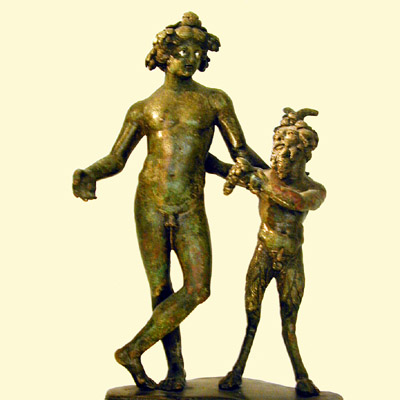| BACCHUS AND PAN |
 |
| BACCHUS AND PAN |
 |
Bacchus was not originally Roman at all but was rather a Latinized form of the Greek Dionysus, god of wine and intoxication, of wild, uncultivated nature, of ritual madness and ecstasy, and of “otherness,”impersonation, and drama. In Greek art Dionysus is often portrayed as an older male with long black hair and beard, wearing animal skins and wreathed with ivy, carrying a sacred thyrsus, a long staff topped with grapes or a pine cone. The worship of Dionysus, involving ecstatic dancing, appealed particularly to women; when Bacchic festivals, called Bacchanalia, were imported into Rome the authorities strongly disapproved. In 186 BCE, the Senate outlawed Bacchic cults and apparently succeeded in suppressing the wilder forms of this worship, although more “domesticated” versions of the cult survived and Bacchic themes were very popular in Roman art, which emphasized Bacchus as a youthful god of wine and the good life.
This Roman bronze figurine, dating from the second century CE, has silver encrusted eyes. Bacchus is shown in typical Roman fashion, as a beardless, rather effeminate youth; he wears a crown of leaves and flowers. He is accompanied by the half-goat, half-human god Pan, patron of shepherds and flocks, whom the Romans identified with Faunus, a native Italian god of the wild forests. In this statuette, Pan offers Bacchus a bunch of grapes.